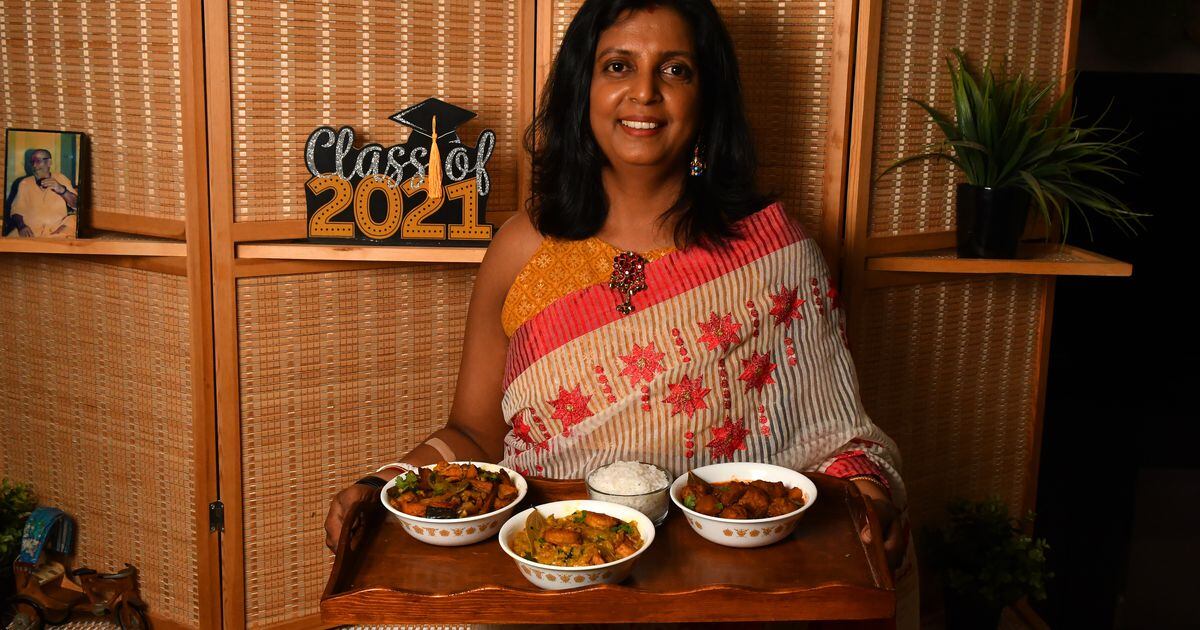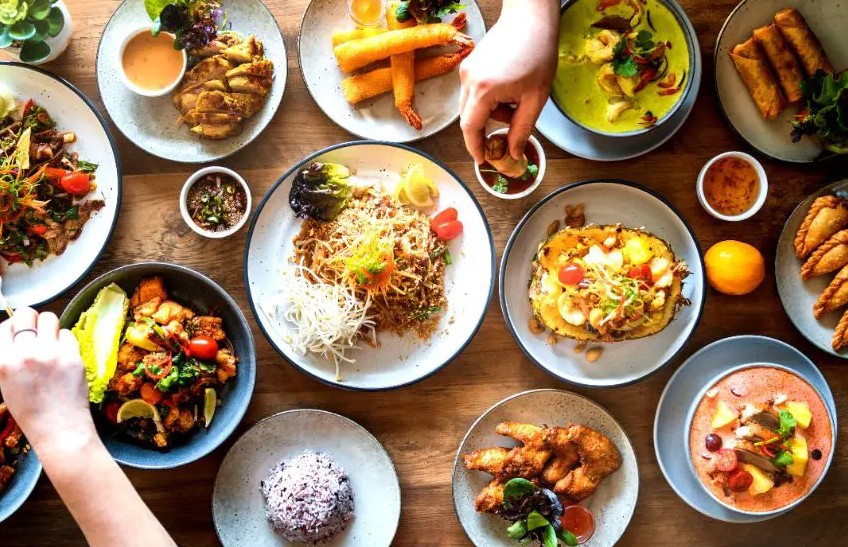
A Chow Club meal is made up of many small courses, and Kar Bhowmik‘s menu followed the pattern. A starter of dal puri was followed by a cup of soup of Bengali yellow split dal, and then a thali-like plate of bottle gourd with shrimp curry, dry Bombay duck curry, jackfruit curry, bottle gourd peel stir-fry and steamed rice. An elephant apple chutney was next and then dessert, sweet cottage cheese dumplings.
“I was excited to share my culture through my food. It’s a way we connect with each other, and a way we gain trust. And as we eat the food of different cultures, we find there are a lot of similarities. I may call it by a different name, or you may cook it in a different way, but we can understand the connections,” Kar Bhowmik said.
RECIPES
Sukanya Kar Bhowmik shared the recipes for three Bengali seafood specialties, two of which she served at her Chow Club dinner. The recipes are lengthy but not difficult, as the length comes from the many spices used in Bengali cooking, spices which give the dishes the name of “curry.” Each is served over rice, and Kar Bhowmik says either basmati or jasmine rice would be traditional.
Ingredients and possible substitutions
Please note where substitutions are suggested, they will bring a different nuance to the dishes. Kar Bhowmik buys her Bangladeshi groceries at Indian Bazaar on North Shallowford Road in Dunwoody and Bangladeshi Grocery Plus on Buford Highway in Doraville.
• Asafoetida, also called hing, is powder made from the tap root of a member of the celery family. It’s commonly used in savory dishes and Indian pickles, and has a distinctly pungent aroma and a sulfur-like flavor similar to alliums like garlic and onions. A mix of garlic powder and onion powder can be substituted.
• Black nigella seeds, also called kalonji or black cumin, are the seeds of the nigella plant and its beautiful blue or white flowers. Black sesame seeds or other dark seeds may be substituted to duplicate the look, but not the flavor.
• Bottle gourd, also known as calabash and called lauki in India, is a long pale green gourd with an edible but slightly tough skin. Frugal Bengali cooks sliver the skin and make a stir-fry by tossing it with matchsticks of potato and sauteing it in mustard oil along with nigella seeds, green finger chiles, poppy seeds and turmeric and seasoning it with curry powder. Zucchini can be used as a substitute for the bottle gourd flesh.
• Dry Bombay duck is a small fish, also called dried loitta, that is sun-dried to preserve it. It is a staple of Bengali cuisine and is available at some Bangladeshi grocery stores and widely available online.
• Garlic paste and ginger paste are available in the produce department of most grocery stores.
• Garam masala is a spice blend and each brand will vary just as curry powders do. Bengali garam masala is a blend of green cardamom, cinnamon and cloves. Most traditional grocery stores will have one or two varieties of garam masala available, each with different spices which may include coriander, cumin or black pepper. You can make your own Bengali garam masala by mixing equal parts ground cardamom, cinnamon and cloves.
• Ghee is clarified butter and is now widely available in grocery and natural food stores. You may also make your own by melting butter and reserving the clear fat, discarding the milk solids that sink to the bottom.
• Green finger chiles are moderately hot. Serrano peppers have a similar level of heat and could be substituted.
• Indian bay leaves are called tej patta, and the flavor is reminiscent of cinnamon and cloves, not at all like the vegetal flavor of American bay leaves. You may substitute a 2-inch piece of cinnamon stick.
• Indian red chili powder is made of powdered hot red chile peppers and packs a major punch. It is hot, but the heat doesn’t linger. Cayenne can be substituted, but the heat from cayenne tends to linger more in the throat, so consider reducing the quantity.
• Mustard oil is pressed from black mustard seeds and is commonly used for cooking and pickling. It is bright yellow and has a high smoke point and a mild mustard sharpness. It can sometimes be found in the international section of grocery stores. Vegetable oil can be substituted.
• Panch phoron is also called “Indian five spice” and is a mix of mustard, cumin, fennel, fenugreek and black nigella seeds. To substitute, use equal quantities of the seeds.
Chitol Macher Muithya (Bengali Fish Curry)
This dish of fish dumplings cooked in spicy onion-tomato gravy is a Bengali specialty made from chitol, a fish that is also called Indian featherback.
Here in the States, we can purchase frozen minced flesh of chitol from Bangladeshi grocers specializing in seafood, or substitute the flesh of a mild fish like tilapia or snapper.
As is traditional, this recipe is very spicy. Lower the heat by lowering the amounts of Indian red chili powder and fresh green finger chiles. You may see similar recipes that prepare the dumplings using mashed potatoes. Kar Bhowmik finds dumplings made without potatoes to be lighter and healthier.
Loitta Shurkir Jhal (Dry Bombay Duck Curry)
This recipe gets its curious name from the dried fish called “dry Bombay duck” that is used. There is no duck in the recipe, and there are many theories about how the fish got this name. The dry Bombay duck fresh out of the package has a very pungent odor, which dissipates as it is soaked. The cooked dry Bombay duck is not fishy tasting at all. If you prefer, make this delicious curry with 1-inch chunks of a meaty fish such as bass or mahi-mahi, adding them at the end and cooking, covered, until the fish is cooked through.
Lau Chingri (Bottle Gourd Curry with Shrimp)
When preparing this dish for her family, Kar Bhowmik uses unpeeled shrimp, and everyone happily consumes the shrimp along with their peel and tails.
Sign up for the AJC Food and Dining Newsletter
Read more stories like this by liking Atlanta Restaurant Scene on Facebook, following @ATLDiningNews on Twitter and @ajcdining on Instagram.








